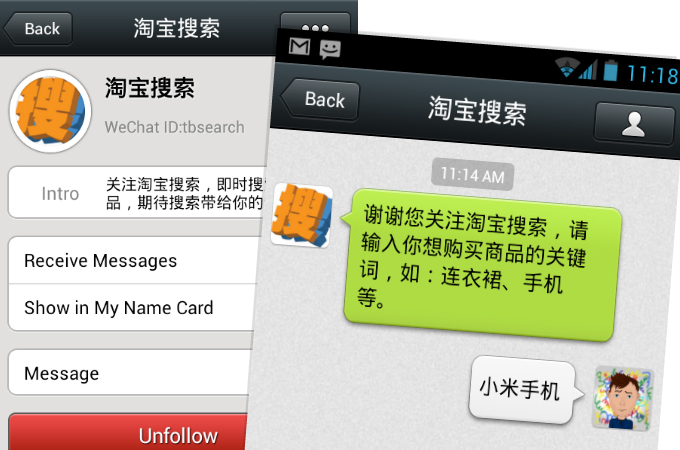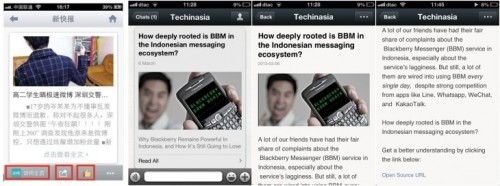We Are Social Asia Tuesday TuneUp #69
WeChat & Taobao testing in-app e-commerce search feature
Tencent’s WeChat is working with China’s largest e-commerce site, Taobao, to test an in-app e-commerce search engine. WeChat users will be able to message Taobao from within the chat app by typing the keywords for the products that they are seeking, and the app will respond with a link to the items. This extension of WeChat’s existing brands platform, which is used for social marketing, makes it easier for users to search Taobao without having to launch the web browser or native app. The search reach will include products listed on Taobao’s sister site, Tmall, also run by Alibaba Group. WeChat’s pending new feature heralds the start of social e-commerce search wave that is expected to boost mobile commerce.
Sina Weibo tests WeChat-like brand platform
WeChat’s rising popularity has reduced the amount of time spent by Sina Weibo’s users on the microblog. Sina is attempting to put up a fight with a new ‘Public Platform’ feature designed to rival WeChat’s brands platform. The feature is still under testing but when launched, it will offer brands, media and advertisers a dedicated channel to reach Sina Weibo’s 500 million registered accounts. This largely mirrors WeChat’s offering with two key differences: (1) WeChat has a smaller userbase of 300 million and (2) Sina’s current system doesn’t support outbound links to drive traffic to brand sites. Nonetheless, the feature is still in beta thus much remains to be seen whether the final launch product will support outbound links that allow advertisers to drive traffic to their own sites. Sina Weibo’s new feature will offer brands a more targeted approach (as users can opt in to receive updates), in addition to the existing promoted messages service which disseminates information to the entire userbase.
WeChat plans to monetize official accounts platform
Monetization has always been tricky even for hot apps like WeChat. Tencent WeChat is looking to monetize the official accounts platform as its users are willing to pay for services. An attractive medium for brands, some of WeChat’s official accounts have started to display ads within articles sent to readers daily. Merchants have also reported seeing traffic from WeChat converting into transactions. In spite of the early commercial success of these services, WeChat maintains that their future monetization efforts will not conflict with user experience. WeChat is always looking to enhance the user experience and its latest version includes a “shake-to-search-for-a-song” feature that makes Shazam-esque song recognition available simply by shaking the phone. Previously, WeChat’s “Shake” feature was used to enable users to meet other users or to transfer web pages. The enhanced feature will soon enable users to launch the official WeChat account for a TV program by shaking the phone while watching the program.
WeChat’s at the top of the Indonesian app chart
China’s WeChat topped Indonesia’s iOS and Android app charts following a TV advertising campaign that started a few weeks ago. The chat app also reached second position on the app chart for Blackberry, Indonesia’s top smartphone platform. WeChat’s dominance on the Android app chart has displaced Japanese app, Line, putting it in second place. It is estimated that there are currently at least a million WeChat users in Indonesia. This development seems to be testimony to WeChat’s partnership with MNC Media, which seems to be paying off in Indonesia, especially for the TV ads. The newly incorporated joint-venture company, MNC Tencent, looks set to overwhelm Line in terms of TV ads and public visibility in the longer term.
Skype powers court proceedings in Indonesia
The Indonesian legal system is harnessing the power of the internet to facilitate court proceedings in a cost-effective manner. For the first time, Skype was used for teleconferencing, allowing a rape victim to deliver her sworn testimony without having to be physically present in court. Though there were hiccups such as the conference call getting disconnected twice, the court process was not disrupted significantly. A far more cost effective substitute to expensive landline-based teleconference calls, the overall success of this hearing could herald the future for legal proceedings.
1/3 of your Facebook friends see your posts
Research by Stanford University’s Michael S. Bernstein has shown that each Facebook update is seen by on average 1/3 of the poster’s friends. The study, which took into account the profiles of 220,000 Facebook users last June, also found that posts across the course of the month reached on average 61% of their friends. This high reach is something most users are unaware of, with most found to “consistently underestimate” the size of their audience.
Facebook’s News feed changes
As we reported last Friday, Facebook have announced a host of changes to their News feed. In the below video, we hear the Facebook team discussing the various differences users will see.
In essence, they have made two major changes. The first of these looks to provide a more visually immersive experience, with large images replacing what the network refer to as ‘clutter’ for everything from photo uploads to article previews and checkins. In fact, the inflated pictures and sleeker left side bar have led many to draw comparisons between the new format and the layout of Google+, a set of similarities highlighted in the following comparison:

It is in the second change that Facebook moves one step beyond its network rival. Rather than just one News feed, users will now have access to a number of different versions, allowing greater control over the stories they see. For example, you can switch from looking at a feed containing purely photos to the activity of all your friends, or the feed containing posts from the celebrities and news sources you ‘follow’.
The changes will post interesting challenges for marketers. First of all, the number and type of feeds will affect the way in which users receive branded content. Whilst the regular News feed will see brands compete with the same stories as they have do currently, the ‘Following’ feed will mean marketers are pitted directly against publishers, as well as celebrities with whom Facebook users have high affinity, increasing ever further the necessity of high-quality content. Moreover, there was no mention in the initial announcement of how adverts will appear in the new feeds. Whilst it is the norm for Facebook’s launches to focus on user experience over advertising and there is no initial change expected, brands will be looking to monitor any expected long term changes and how these may affect social strategy.
Tumblr to introduce mobile advertising
In an attempt at monetisation, Tumblr is set to introduce advertising on its mobile app, much like it already has on desktop. In the first half of this year, companies will be able to promote posts via mobile as well as web. This comes at the same time as research from Gartner on the increasing power of mobile advertising. This year expects to see $11.4 billion in worldwide mobile advertising revenue, up from $9.8 billion in 2012. By 2016, this could increase to $24.6 billion.
Red Bull introduce ‘Flow’
Red Bull are expanding both their social portfolio and association with the world of extreme sports by introducing Flow, a trick-sharing app designed for skateboarders and BMXers. Available for iPhone and Android, Flow allows users to either record in-app or upload pre-recorded content, which it then converts from individual clips to a seamless ‘flow’ of content.

Mothercare producing film for Mother’s Day
We hope any mums reading had a great Mother’s Day yesterday! To celebrate the event, Mothercare are producing a user-generated film about a day in the life of a mother, due to be posted on their Facebook page today. The video, directed by Susie Donaldson of ‘Child of our Time’, is a collation of various photo and video content sent to the brand’s social platforms with the hashtag #MothersDayMoments.
Hospitals’ Facebook likes increase with quality
There is a link between a hospital’s quality and the number of Facebook likes it has, according to research by the American Journal of Medical Quality. Whilst social networks are not prevalent in the US healthcare sector – note that below 50% of the 82 New York-based locations tested even had a Facebook page – those that existed in the social sphere gained on average 93 likes with every percentage-point drop in the mortality rate. Furthermore, there is a positive correlation between a hospital’s fan numbers and the positive reviews it receives, depicting the ever-growing nature of social recommendations in non-commercial spheres.



